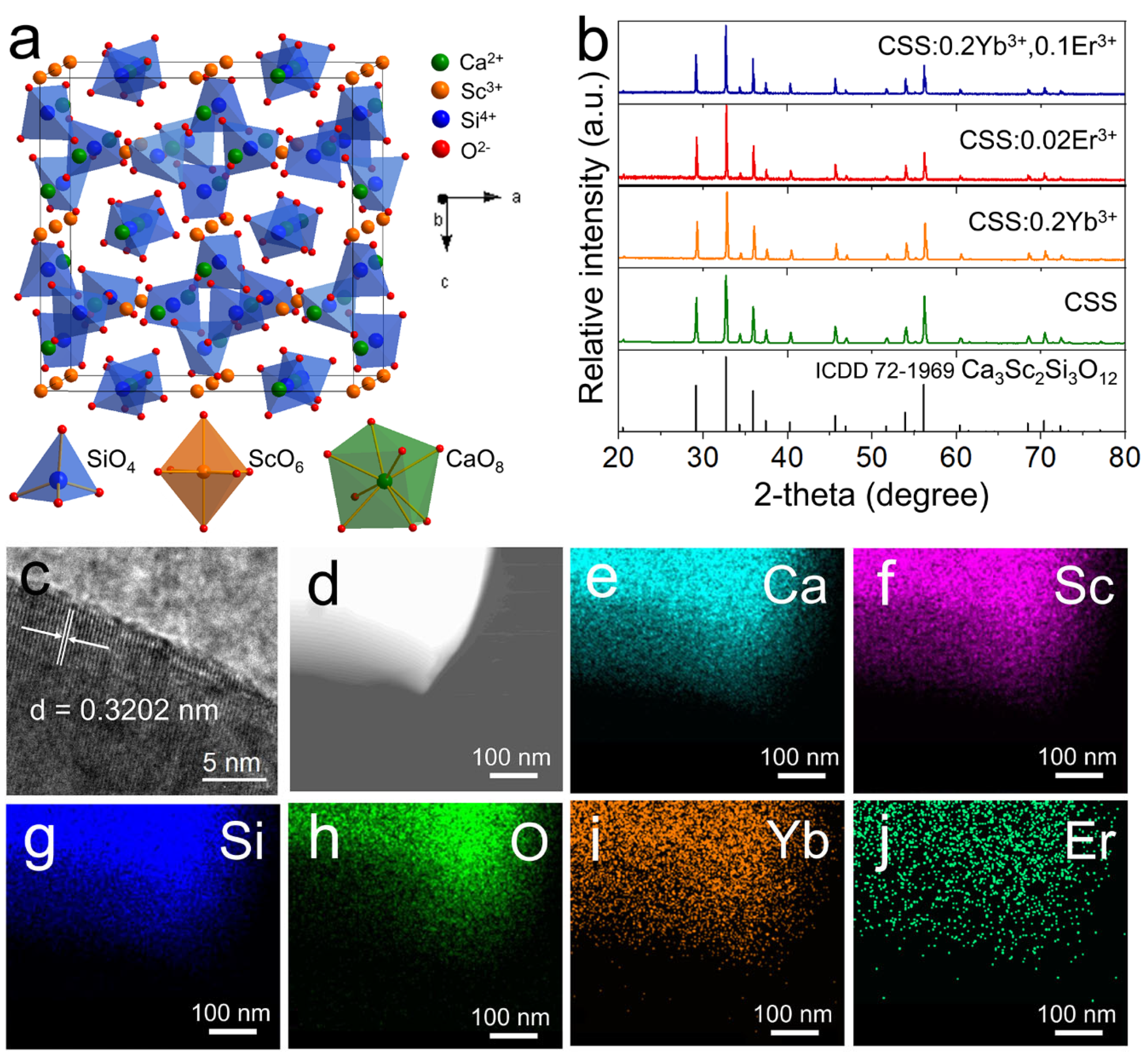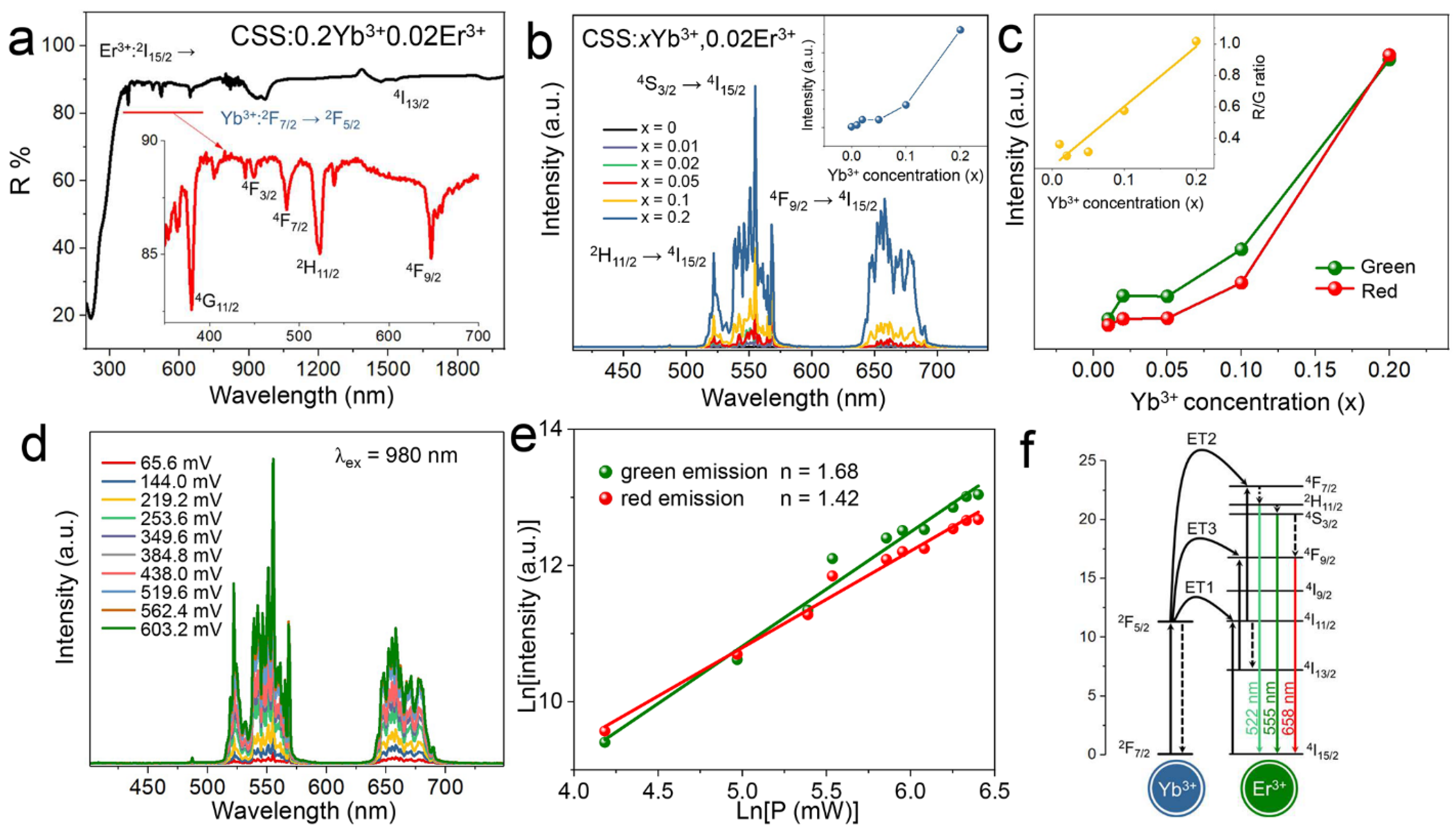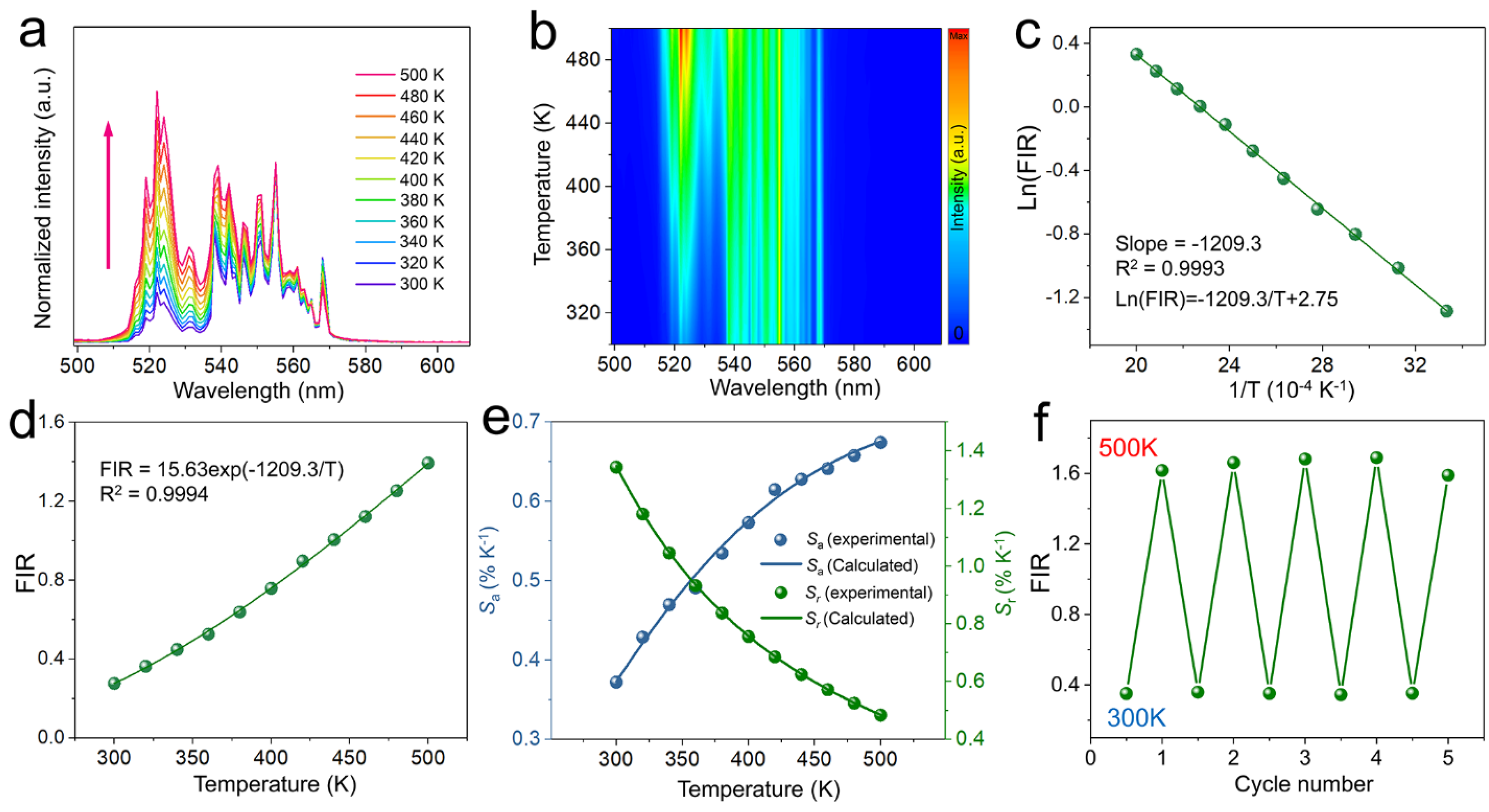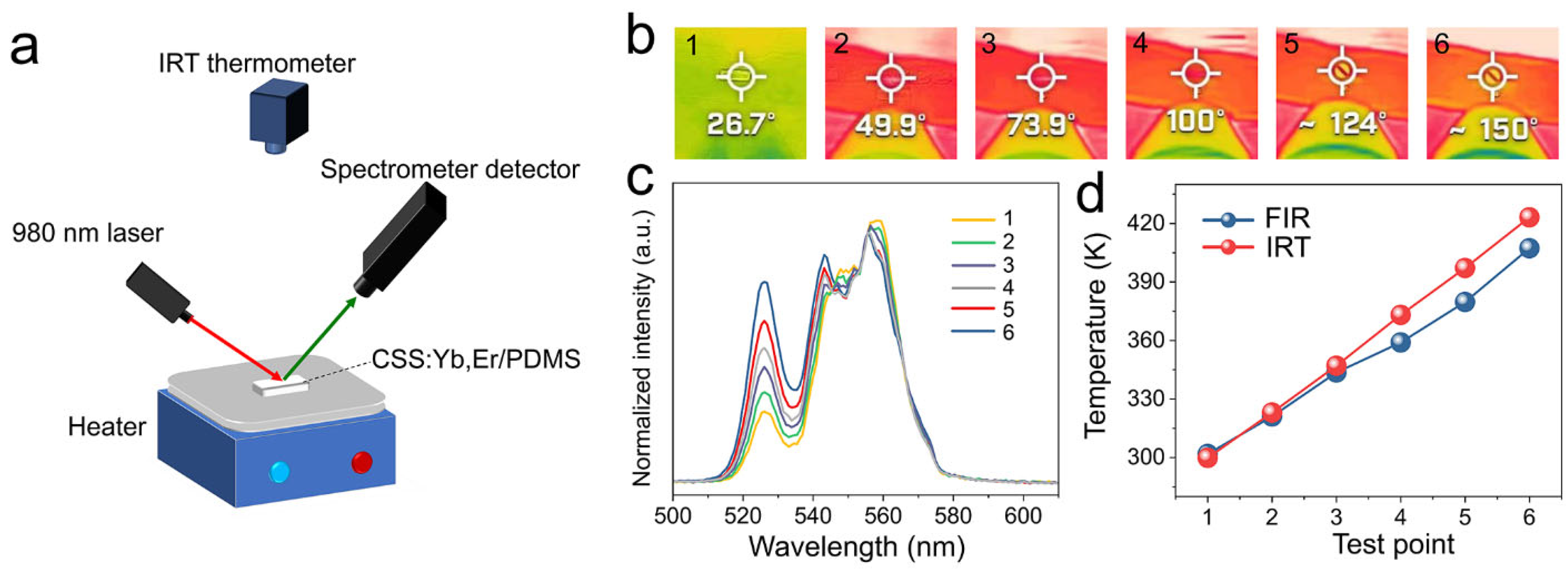The Upconversion Luminescence of Ca3Sc2Si3O12:Yb3+,Er3+ and Its Application in Thermometry
Abstract
1. Introduction
2. Materials and Methods
3. Results and Discussion
4. Conclusions
Supplementary Materials
Author Contributions
Funding
Data Availability Statement
Conflicts of Interest
References
- Fischer, L.H.; Harms, G.S.; Wolfbeis, O.S. Upconverting nanoparticles for nanoscale thermometry. Angew. Chem. Int. Ed. 2011, 50, 4546–4551. [Google Scholar] [CrossRef] [PubMed]
- Bao, G.; Wong, K.L.; Jin, D.; Tanner, P.A. A stoichiometric terbium-europium dyad molecular thermometer: Energy transfer properties. Light Sci. Appl. 2018, 7, 96. [Google Scholar] [CrossRef] [PubMed]
- Pan, Y.; Xie, X.; Huang, Q.; Gao, C.; Wang, Y.; Wang, L.; Yang, B.; Su, H.; Huang, L.; Huang, W. Inherently Eu2+/Eu3+ Codoped Sc2O3 Nanoparticles as High-Performance Nanothermometers. Adv. Mater. 2018, 30, e1705256. [Google Scholar] [CrossRef] [PubMed]
- Dramićanin, M.D. Trends in luminescence thermometry. J. Appl. Phys. 2020, 128, 040902. [Google Scholar] [CrossRef]
- Li, K.; Zhu, D.; Yue, C. Exceptional low-temperature fluorescence sensing properties in novel KBaY(MoO4)3:Yb3+,Ho3+ materials based on FIR of Ho3+ transitions 5F5(1) → 5I8/5S2 → 5I8. J. Mater. Chem. C 2022, 10, 6603–6610. [Google Scholar] [CrossRef]
- Li, Z.; Han, Q.; Yan, T.; Huang, Z.; Song, Y.; Wang, Y.; Zhang, X. Up-conversion luminescence and optical temperature sensing of Er3+, Yb3+ co-doped Gd2O3 phosphors with different F-/Ln3+. J. Alloys Compd. 2022, 904, 164009. [Google Scholar] [CrossRef]
- Mullins, A.L.; Ćirić, A.; Zeković, I.; Williams, J.A.G.; Dramićanin, M.D.; Evans, I.R. Dual-emission luminescence thermometry using LaGaO3:Cr3+, Nd3+ phosphors. J. Mater. Chem. C 2022, 10, 10396–10403. [Google Scholar] [CrossRef]
- Yan, T.; Han, Q.; Li, Z.; Song, Y.; Wang, Y.; Zhang, X. Influence of rare earth doping and calcination temperature on temperature sensitivity of gadolinium molybdate nanoparticle. J. Alloys Compd. 2022, 907, 164462. [Google Scholar] [CrossRef]
- Wang, C.; Jin, Y.; Yuan, L.; Wu, H.; Ju, G.; Li, Z.; Liu, D.; Lv, Y.; Chen, L.; Hu, Y. A spatial/temporal dual-mode optical thermometry platform based on synergetic luminescence of Ti4+-Eu3+ embedded flexible 3D micro-rod arrays: High-sensitive temperature sensing and multi-dimensional high-level secure anti-counterfeiting. Chem. Eng. J. 2019, 374, 992–1004. [Google Scholar] [CrossRef]
- Vetrone, F.; Naccache, R.; Zamarron, A.; Juarranz de la Fuente, A.; Sanz-Rodriguez, F.; Martinez Maestro, L.; Martin Rodriguez, E.; Jaque, D.; Garcia Sole, J.; Capobianco, J.A. Temperature sensing using fluorescent nanothermometers. ACS Nano 2010, 4, 3254–3258. [Google Scholar] [CrossRef]
- Liu, S.; Cui, J.; Jia, J.; Fu, J.; You, W.; Zeng, Q.; Yang, Y.; Ye, X. High sensitive Ln3+/Tm3+/Yb3+ (Ln3+=Ho3+, Er3+) tri-doped Ba3Y4O9 upconverting optical thermometric materials based on diverse thermal response from non-thermally coupled energy levels. Ceram. Int. 2019, 45, 1–10. [Google Scholar] [CrossRef]
- Wang, Y.; Li, Y.; Ma, C.; Wen, Z.; Yuan, X.; Cao, Y. Temperature sensing properties of NaYTiO4: Yb/Tm phosphors based on near-infrared up-conversion luminescence. J. Lumin. 2022, 248, 118917. [Google Scholar] [CrossRef]
- Xu, W.; Zhao, L.; Shang, F.; Zheng, L.; Zhang, Z. Modulating the thermally coupled status of energy levels in rare earth ions for sensitive optical temperature sensing. J. Lumin. 2022, 249, 119042. [Google Scholar] [CrossRef]
- Kore, B.P.; Kumar, A.; Erasmus, L.; Kroon, R.E.; Terblans, J.J.; Dhoble, S.J.; Swart, H.C. Energy Transfer Mechanisms and Optical Thermometry of BaMgF4:Yb3+,Er3+ Phosphor. Inorg. Chem. 2018, 57, 288–299. [Google Scholar] [CrossRef] [PubMed]
- Fan, S.; Gao, G.; Sun, S.; Fan, S.; Sun, H.; Hu, L. Absolute up-conversion quantum efficiency reaching 4% in β-NaYF4:Yb3+,Er3+ micro-cylinders achieved by Li+/Na+ ion-exchange. J. Mater. Chem. C 2018, 6, 5453–5461. [Google Scholar] [CrossRef]
- Ma, Z.; Gou, J.; Zhang, Y.; Man, Y.; Li, G.; Li, C.; Tang, J. Yb3+/Er3+ co-doped Lu2TeO6 nanophosphors: Hydrothermal synthesis, upconversion luminescence and highly sensitive temperature sensing performance. J. Alloys Compd. 2019, 772, 525–531. [Google Scholar] [CrossRef]
- Wu, H.; Hao, Z.; Zhang, L.; Zhang, X.; Xiao, Y.; Pan, G.-H.; Wu, H.; Luo, Y.; Zhang, L.; Zhang, J. Er3+/Yb3+ codoped phosphor Ba3Y4O9 with intense red upconversion emission and optical temperature sensing behavior. J. Mater. Chem. C 2018, 6, 3459–3467. [Google Scholar] [CrossRef]
- Zhang, J.; Zhang, Y.; Jiang, X. Investigations on upconversion luminescence of K3Y(PO4)2:Yb3+-Er3+/Ho3+/Tm3+ phosphors for optical temperature sensing. J. Alloys Compd. 2018, 748, 438–445. [Google Scholar] [CrossRef]
- Du, P.; Su Yu, J. Effect of molybdenum on upconversion emission and temperature sensing properties in Na0.5Bi0.5TiO3:Er/Yb ceramics. Ceram. Int. 2015, 41, 6710–6714. [Google Scholar] [CrossRef]
- Zhou, L.; Tanner, P.A.; Zhou, W.; Ai, Y.; Ning, L.; Wu, M.M.; Liang, H. Unique Spectral Overlap and Resonant Energy Transfer between Europium(II) and Ytterbium(III) Cations: No Quantum Cutting. Angew. Chem. Int. Ed. 2017, 56, 10357–10361. [Google Scholar] [CrossRef]
- Sun, Z.; Jia, M.; Lin, F.; Hou, B.; Fu, Z.; Yang, X. Choice of low thermal quenching phosphors based on high lattice energy for light-emitting application. J. Lumin. 2020, 222, 117098. [Google Scholar] [CrossRef]
- Wu, H.; Pan, G.-H.; Hao, Z.; Zhang, L.; Wu, H.; Zhang, J. Highly efficient and thermally robust cyan-green phosphor-in-glass films for high-brightness laser lighting. J. Mater. Chem. C 2021, 9, 12342–12352. [Google Scholar] [CrossRef]
- Zhou, Y.; Li, X.; Seto, T.; Wang, Y. A High Efficiency Trivalent Chromium-Doped Near-Infrared-Emitting Phosphor and Its NIR Spectroscopy Application. ACS Sustain. Chem. Eng. 2021, 9, 3145–3156. [Google Scholar] [CrossRef]
- Xu, D.; Liu, C.; Yan, J.; Yang, S.; Zhang, Y. Understanding Energy Transfer Mechanisms for Tunable Emission of Yb3+-Er3+ Codoped GdF3 Nanoparticles: Concentration-Dependent Luminescence by Near-Infrared and Violet Excitation. J. Phys. Chem. C 2015, 119, 6852–6860. [Google Scholar] [CrossRef]
- Li, A.; Xu, D.; Zhang, Y.; Lin, H.; Yang, S.; Chen, Z.; Shao, Y.; Setlur, A. Upconversion Luminescence and Energy-Transfer Mechanism of NaGd(MoO4)2: Yb3+/Er3+ Microcrystals. J. Am. Ceram. Soc. 2016, 99, 1657–1663. [Google Scholar] [CrossRef]
- Tian, Y.; Tian, Y.; Huang, P.; Wang, L.; Shi, Q.; Cui, C. Effect of Yb3+ concentration on upconversion luminescence and temperature sensing behavior in Yb3+/Er3+ co-doped YNbO4 nanoparticles prepared via molten salt route. Chem. Eng. J. 2016, 297, 26–34. [Google Scholar] [CrossRef]
- Hu, F.; Cao, J.; Wei, X.; Li, X.; Cai, J.; Guo, H.; Chen, Y.; Duan, C.-K.; Yin, M. Luminescence properties of Er3+-doped transparent NaYb2F7 glass-ceramics for optical thermometry and spectral conversion. J. Mater. Chem. C 2016, 4, 9976–9985. [Google Scholar] [CrossRef]
- Guan, M.; Zheng, H.; Mei, L.; Molokeev, M.S.; Xie, J.; Yang, T.; Wu, X.; Huang, S.; Huang, Z.; Setlur, A. Preparation, Structure, and Up-Conversion Luminescence of Yb3+/Er3+ Codoped SrIn2O4 Phosphors. J. Am. Ceram. Soc. 2015, 98, 1182–1187. [Google Scholar] [CrossRef]
- Pollnau, M.; Gamelin, D.R.; Luthi, S.R.; Gudel, H.U.; Hehlen, M.P. Power dependence of upconversion luminescence in lanthanide and transition-metal-ion systems. Phys. Rev. B 2000, 61, 3337–3346. [Google Scholar] [CrossRef]
- Mai, H.-X.; Zhang, Y.-W.; Sun, L.-D.; Yan, C.-H. Highly Efficient Multicolor Up-Conversion Emissions and Their Mechanisms of Monodisperse NaYF4: Yb,Er Core and Core/Shell-Structured Nanocrystals. J. Phys. Chem. C 2007, 111, 13721–13729. [Google Scholar] [CrossRef]
- Dong, H.; Sun, L.D.; Yan, C.H. Energy transfer in lanthanide upconversion studies for extended optical applications. Chem. Soc. Rev. 2015, 44, 1608–1634. [Google Scholar] [CrossRef] [PubMed]
- Collins, S.F.; Baxter, G.W.; Wade, S.A.; Sun, T.; Grattan, K.T.V.; Zhang, Z.Y.; Palmer, A.W. Comparison of fluorescence-based temperature sensor schemes: Theoretical analysis and experimental validation. J. Appl. Phys. 1998, 84, 4649–4654. [Google Scholar] [CrossRef]
- Wade, S.A.; Collins, S.F.; Baxter, G.W. Fluorescence intensity ratio technique for optical fiber point temperature sensing. J. Appl. Phys. 2003, 94, 4743–4756. [Google Scholar] [CrossRef]
- León-Luis, S.F.; Rodríguez-Mendoza, U.R.; Haro-González, P.; Martín, I.R.; Lavín, V. Role of the host matrix on the thermal sensitivity of Er3+ luminescence in optical temperature sensors. Sens. Actuat. B Chem. 2012, 174, 176–186. [Google Scholar] [CrossRef]
- Wang, X.; Liu, Q.; Bu, Y.; Liu, C.-S.; Liu, T.; Yan, X. Optical temperature sensing of rare-earth ion doped phosphors. RSC Adv. 2015, 5, 86219–86236. [Google Scholar] [CrossRef]
- Wei, T.; Yang, F.; Jia, B.; Zhao, C.; Wang, M.; Du, M.; Zhou, Q.; Guo, Y.; Li, Z. High performance temperature sensing and optical heating of Tm3+- and Yb3+- codoped SrBi4Ti4O15 up-conversion luminescence nanoparticles. Ceram. Int. 2019, 45, 18084–18090. [Google Scholar] [CrossRef]
- Singh, S.K.; Kumar, K.; Rai, S.B. Er3+/Yb3+ codoped Gd2O3 nano-phosphor for optical thermometry. Sens. Actuat. A Phys. 2009, 149, 16–20. [Google Scholar] [CrossRef]
- Du, P.; Luo, L.; Yue, Q.; Li, W. The simultaneous realization of high- and low-temperature thermometry in Er3+/Yb3+-codoped Y2O3 nanoparticles. Mater. Lett. 2015, 143, 209–211. [Google Scholar] [CrossRef]
- Dong, B.; Liu, D.P.; Wang, X.J.; Yang, T.; Miao, S.M.; Li, C.R. Optical thermometry through infrared excited green upconversion emissions in Er3+-Yb3+ codoped Al2O3. Appl. Phys. Lett. 2007, 90, 181117. [Google Scholar] [CrossRef]
- Xiang, G.; Liu, X.; Zhang, J.; Liu, Z.; Liu, W.; Ma, Y.; Jiang, S.; Tang, X.; Zhou, X.; Li, L.; et al. Dual-Mode Optical Thermometry Based on the Fluorescence Intensity Ratio Excited by a 915 nm Wavelength in LuVO4:Yb3+/Er3+@SiO2 Nanoparticles. Inorg. Chem. 2019, 58, 8245–8252. [Google Scholar] [CrossRef]
- Wang, Z.; Jiao, H.; Fu, Z. Investigating the Luminescence Behaviors and Temperature Sensing Properties of Rare-Earth-Doped Ba2In2O5 Phosphors. Inorg. Chem. 2018, 57, 8841–8849. [Google Scholar] [CrossRef] [PubMed]
- Jiang, Y.; Tong, Y.; Chen, S.; Zhang, W.; Hu, F.; Wei, R.; Guo, H. A three-mode self-referenced optical thermometry based on up-conversion luminescence of Ca2MgWO6:Er3+,Yb3+ phosphors. Chem. Eng. J. 2021, 413, 127470. [Google Scholar] [CrossRef]
- Ma, Y.; Xiang, G.; Zhang, J.; Liu, Z.; Zhou, P.; Liu, W.; Tang, X.; Jiang, S.; Zhou, X.; Li, L.; et al. Upconversion properties and temperature sensing behaviors in visible and near-infrared region based on fluorescence intensity ratio in LuVO4: Yb3+/Er3+. J. Alloys Compd. 2018, 769, 325–331. [Google Scholar] [CrossRef]




| Phosphor | Temperature Range (K) | Sa-Max(% K−1) | Sr-Max (% K−1) | Ref. |
|---|---|---|---|---|
| Ba3Y4O9:Yb3+,Er3+ | 83–563 | 0.248 (563 K) | / | [17] |
| K3Y(PO4)2:Yb3+,Er3+ | 293–553 | 0.304 (553 K) | 1.31 (239 K) | [18] |
| Na0.5Bi0.5TiO3:Yb3+,Er3+ | 93–553 | 0.35 (493 K) | / | [19] |
| Gd2O3:Yb3+,Er3+ | 300–900 | 0.39 (300 K) | / | [37] |
| NaYF4:Yb3+,Er3+ | 293–753 | 0.39 (500 K) | 1.3 (293 K) | [15] |
| Y2O3:Yb3+,Er3+ | 93–613 | 0.44 (427 K) | / | [38] |
| Al2O3:Yb3+,Er3+ | 295–973 | 0.51 (495 K) | / | [39] |
| LuVO4:Yb3+,Er3+@SiO2 | 303–353 | 0.572 (353 K) | 1.173 (303 K) | [40] |
| Ba2In2O5:Yb3+,Er3+ | 303–573 | 0.65 (498 K) | / | [41] |
| Ca2MgWO6:Yb3+,Er3+ | 303–573 | 0.82 (453 K) | 0.92 (303 K) | [42] |
| LuVO4:Yb3+,Er3+ | 303–423 | 0.82 (423 K) | 1.12 (303 K) | [43] |
| CSS:Yb3+,Er3+ | 300–500 | 0.67 (500 K) | 1.34 (300 K) | This work |
Disclaimer/Publisher’s Note: The statements, opinions and data contained in all publications are solely those of the individual author(s) and contributor(s) and not of MDPI and/or the editor(s). MDPI and/or the editor(s) disclaim responsibility for any injury to people or property resulting from any ideas, methods, instructions or products referred to in the content. |
© 2023 by the authors. Licensee MDPI, Basel, Switzerland. This article is an open access article distributed under the terms and conditions of the Creative Commons Attribution (CC BY) license (https://creativecommons.org/licenses/by/4.0/).
Share and Cite
Hong, J.; Liu, F.; Dramićanin, M.D.; Zhou, L.; Wu, M. The Upconversion Luminescence of Ca3Sc2Si3O12:Yb3+,Er3+ and Its Application in Thermometry. Nanomaterials 2023, 13, 1910. https://doi.org/10.3390/nano13131910
Hong J, Liu F, Dramićanin MD, Zhou L, Wu M. The Upconversion Luminescence of Ca3Sc2Si3O12:Yb3+,Er3+ and Its Application in Thermometry. Nanomaterials. 2023; 13(13):1910. https://doi.org/10.3390/nano13131910
Chicago/Turabian StyleHong, Junyu, Feilong Liu, Miroslav D. Dramićanin, Lei Zhou, and Mingmei Wu. 2023. "The Upconversion Luminescence of Ca3Sc2Si3O12:Yb3+,Er3+ and Its Application in Thermometry" Nanomaterials 13, no. 13: 1910. https://doi.org/10.3390/nano13131910
APA StyleHong, J., Liu, F., Dramićanin, M. D., Zhou, L., & Wu, M. (2023). The Upconversion Luminescence of Ca3Sc2Si3O12:Yb3+,Er3+ and Its Application in Thermometry. Nanomaterials, 13(13), 1910. https://doi.org/10.3390/nano13131910








